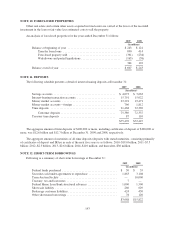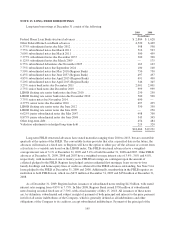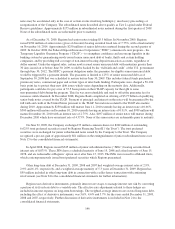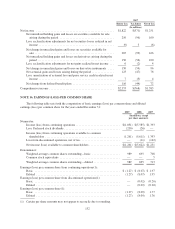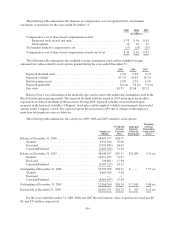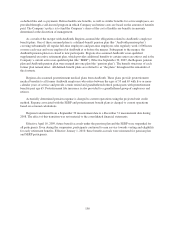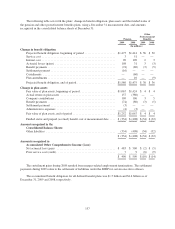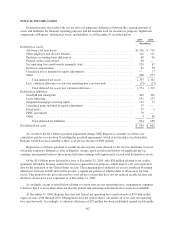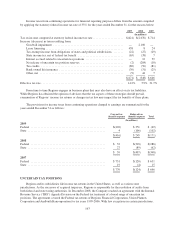Regions Bank 2009 Annual Report Download - page 167
Download and view the complete annual report
Please find page 167 of the 2009 Regions Bank annual report below. You can navigate through the pages in the report by either clicking on the pages listed below, or by using the keyword search tool below to find specific information within the annual report.The effect from the assumed issuance of 61 million common shares upon conversion of mandatorily
convertible preferred stock was not included in the above computations of diluted earnings (loss) per common
share because such amounts would have had an antidilutive effect on earnings (loss) per common share for 2009
(see Note 15 to the consolidated financial statements.) The effect from the assumed exercise of 53 million,
53 million and 31 million stock options was not included in the above computations of diluted earnings (loss) per
common share for 2009, 2008 and 2007, respectively, because such amounts would have had an antidilutive
effect on earnings (loss) per common share.
NOTE 17. SHARE-BASED PAYMENTS
Regions has stock option and long-term incentive compensation plans, which permit the granting of
incentive awards in the form of stock options, restricted stock, restricted stock units and stock appreciation rights.
While Regions has the ability to issue stock appreciation rights, as of December 31, 2009, 2008 and 2007, there
were no outstanding stock appreciation rights. The terms of all awards issued under these plans are determined
by the Compensation Committee of the Board of Directors, but no options may be granted after the tenth
anniversary of the plans’ adoption. Options and restricted stock granted usually vest based on employee service
and generally vest within three years from the date of the grant. Grants of performance-based restricted stock
typically have a one-year performance period, after which shares vest within three years after the grant date.
Restricted stock units, which were granted in 2008, have a vesting period of five years. Generally, the terms of
these plans stipulate that the exercise price of options may not be less than the fair market value of Regions’
common stock at the date the options are granted; however, under prior stock option plans, non-qualified options
could be granted with a lower exercise price than the fair market value of Regions’ common stock on the date of
grant. The contractual life of options granted under these plans ranges from seven to ten years from the date of
grant. Regions issues new shares from authorized reserves upon exercise. Grantees of restricted stock awards or
units must either remain employed with the Company for certain periods from the date of grant in order for
shares to be released or issued or retire after meeting the standards of a retiree, at which time shares would be
prorated and released. Upon adoption of a new long-term incentive plan in 2006, Regions amended all other open
stock and long-term incentive plans, such that no new awards may be granted under those plans subsequent to the
amendment date. The outstanding awards were unaffected by this plan amendment. The plan adopted in 2006
provides that 20,000,000 common share equivalents are subject to and available for distribution to recipients.
Each share of restricted stock granted under the 2006 plan is assigned a share equivalent factor of 4.0, as
compared to the stock option equivalent factor of 1.0. The number of remaining share equivalents authorized for
issuance under Regions’ long-term compensation plans was approximately 4,290,000 share equivalents at
December 31, 2009.
In 2009, Regions made a stock option grant that vests based upon a service condition and a market condition
in addition to awards that were similar to prior grants. The fair value of these stock options was estimated on the
date of the grant using a Monte-Carlo simulation method. The simulation generates a defined number of stock
price paths in order to develop a reasonable estimate of the range of future expected stock prices and minimize
standard error. For all other grants that vest solely upon a service condition, the fair value of stock options is
estimated at the date of the grant using a Black-Scholes option pricing model and related assumptions.
In connection with the AmSouth acquisition, Regions assumed AmSouth’s long-term incentive plans. The
awards issued under these plans are consistent with the awards issued under Regions’ plans described above.
However, all unvested awards vest upon the employee’s retirement. Also, in determining shares authorized,
restricted stock grants are equally weighted with stock options. At December 31, 2009, approximately 3,358,000
shares were authorized for issuance under these assumed plans. In other business combinations prior to 2006,
Regions assumed stock options that were previously granted by those companies and converted those options,
based on the appropriate exchange ratio, into options to acquire Regions’ common stock. The common stock for
such options has been registered under the Securities Act of 1933 by Regions and is not included in the
maximum number of shares that may be granted by Regions under its existing stock option plans.
153


